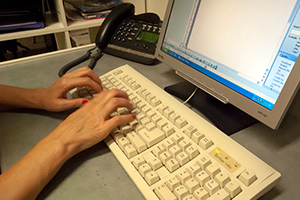INTERMEDIATE COMPUTER SERVICING - DISTANCE LEARNING COURSE
The urge to upgrade, repair or just tinker with the insides of a computer system can be quite strong in some people. Initially the task might seem daunting, however with experience and a little guidance most repairs can be undertaken, hardware components installed or adjusted for optimal performance.
For the first timer, the process can seem to be fraught with danger, and in terms of doing more damage than good it can be. If you follow a few basic steps though you should be able to work quite safely, both from your own and the computers point of view.
This course takes the skills that have been learnt in Computer Servicing I and builds on them to develop an enhanced level of understanding and capabilities.
Pre-requisites: Computer Servicing I (or equivalent).

There are 10 lessons in this course:
- Introduction to hardware components
- Introduction
- Random Access Memory (RAM)
- Types of RAM
- Dynamic RAM
- Tips for buying RAM
- How to add memory to a computer
- Problems when installing memory
- Central Processing Unit (CPU)
- Considerations when buying a new CPU
- Graphic card
- How to install a graphics card
- Installing a CD or DVD burner
- Jumper switch settings
- Hard disk upgrade
- Installing a back up drive
- Basic Diagnostic Equipment
- Introduction
- Software diagnosis
- Temperature monitor
- Registry cleaner, virus scanner and spyware detector
- USB port tester
- Power supply tester
- CPU meter
- Hard disk tester
- Electric Circuits and Components
- Understanding electricity
- Circuits
- Measuring electricity
- Ohm's law
- Power
- Problem Solving and Fault Analysis
- Introduction
- Problem solving
- Request response, result strategy
- The circle back model
- Pitfalls in problem solving
- How to troubleshoot and isolate computer problems
- Hardware failures
- Software failures
- Recreating a problem; reproducing the error
- Diagnostic Testing [A] (Self Tests and Diagnostic Cards)
- Power up
- Boot drive
- Errant keyboard
- Mouse problems
- Slow computer performance
- Computer freezes and displays BSOD (Blue screen of death)
- No display on monitor
- No sound
- Computer rebooting or turning itself off
- How to troubleshoot a computer that does not boot
- Diagnostic Testing [B] (System Board and Memory Tests)
- Components overview
- Operating system diagnostics
- Software maintenance and troubleshooting
- Software and hardware
- Operating systems
- Command prompts
- SOS, DIR command
- Formatting
- File types
- Back up (all types)
- Copy
- Print
- Erasing files
- Autoexec.bat and Config.sys
- History of windows
- Viruses
- Data corruption
- Disk drives and CD-ROM
- Servicing CD Rom drive
- RAM servicing
- Video and Audio Systems
- Video cards
- Troubleshooting a graphics card
- Sound cards and troubleshooting
- Developing a Maintenance Program
- Work scheduling
- Project component estimate form
- Performing routine computer maintenance
Each lesson culminates in an assignment which is submitted to the school, marked by the school's tutors and returned to you with any relevant suggestions, comments, and if necessary, extra reading.
Aims
- Identify a variety of basic computer system components and, describe how they can be interchanged and upgraded in a personal computer.
- Explain equipment used for monitoring the condition of electrical equipment and software
- Develop a better understanding of basic electronics, as a background to understanding some parts of a computer system
- Develop a systematic approach to solving problems with computers.
- Develop a basic understanding of diagnostic testing with self tests and diagnostic cards.
- Further develop your understanding and skills in diagnostic testing.
- Develop a basic understanding of system software maintenance procedures to be used in computer servicing
- Develop a better understanding of memory storage devices and their servicing.
- Develop a better understanding of video and audio equipment and their servicing.
What you will do?
- Explain how to dismantle a Personal Computer
- Explain how to reassemble a dismantled personal computer
- Analyse potential hardware faults that may occur in different computer systems.
- Determine likely causes of potential hardware faults, including faulty equipment, damage to equipment
- Analyse potential software faults that may occur in different computer systems.
- Determine likely causes of potential software faults, including faulty equipment, power surges
- Describe causes of data corruption
- Describe ways of addressing software problems including data corruption.
- Develop a procedure for routine maintenance of a specific computer system.
- Demonstrate a basic understanding of three different operating systems
- Outline the role of ROM BIOS.
- Explain a range of common computer hardware faults which are easily repaired by a technician.
- Test cables for faulty operation
- Explain faults which can occur with a VDU
- Explain how to use several different hardware diagnostic tools
- Determine procedures to minimise risk of computer problems including equipment breakdowns and data loss.
- Explain a range of common computer software faults which are easily repaired by a technician.
- Test different software for faulty operation
- Explain how to use several different software diagnostic tools